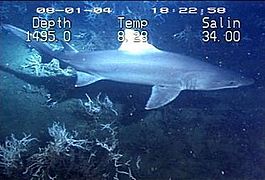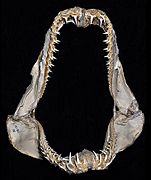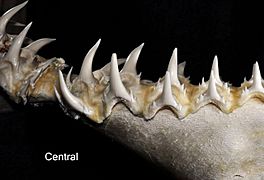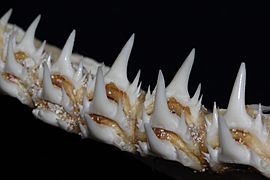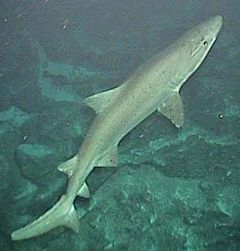Smalltooth sand tiger facts for kids
Quick facts for kids Smalltooth sand tiger |
|
|---|---|
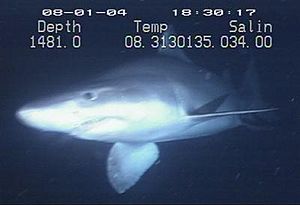 |
|
| Conservation status | |
| Scientific classification | |
| Genus: |
Odontaspis
|
| Species: |
ferox
|
 |
|
| Range of the smalltooth sand tiger | |
| Synonyms | |
|
Odontaspis herbsti Whitley, 1950 |
|
The smalltooth sand tiger (Odontaspis ferox) is a type of mackerel shark. It is also known as the bumpytail ragged-tooth. These sharks live in tropical and warm waters around the world. They are often found in deep, rocky areas of the ocean. Sometimes, they can be seen in shallower waters too. Scientists have even noticed that some sharks return to the same spots every year.
This shark is quite rare. People sometimes confuse it with the more common grey nurse shark. You can tell them apart because the smalltooth sand tiger's first dorsal fin is bigger than its second. This fin is also placed further forward on its body. These sharks can grow to be at least 4.1 meters (13.5 feet) long.
We don't know a lot about the smalltooth sand tiger's life. It is an active hunter that eats bony fish, invertebrates, and cartilaginous fish that live near the ocean floor. Like other mackerel sharks, it is thought to be ovoviviparous. This means the eggs hatch inside the mother's body. The young sharks then feed on other eggs before they are born. Even though it looks big and strong, this shark is not dangerous to humans. There are no reports of it ever attacking people. Scientists are worried that its numbers might be going down. This is due to human activities, especially in the Mediterranean Sea.
Contents
About the Smalltooth Sand Tiger
The smalltooth sand tiger was first described in 1810 by a naturalist named Antoine Risso. He called it Squalus ferox. The name ferox comes from Latin and means "fierce." Other common names for this shark include blue nurse shark and fierce shark.
Scientists have studied the shark's mitochondrial DNA. This research suggests that the smalltooth sand tiger is more closely related to thresher sharks than to the grey nurse shark. This is interesting because they look very similar. It means they might have developed similar features over time, which is called convergent evolution. Scientists have found Fossil teeth of this shark. These teeth are from about 5.3 to 3.6 million years ago. They were found in places like Italy and Venezuela.
Appearance and Features
The smalltooth sand tiger has a strong body. Its snout is long, rounded, and a bit flat. Its eyes are medium-sized with large, round pupils. Unlike some other sharks, it does not have special eyelids called nictitating membranes.
The shark has a large mouth full of pointy teeth. Each tooth has a tall, narrow point in the middle. On each side of this main point, there are two or three smaller points. The upper jaw has about 48 to 56 rows of teeth. The lower jaw has about 36 to 46 rows.
The fins of this shark are wide and have sharp angles. The first dorsal fin is bigger than the second. It is also placed closer to the pectoral fins (side fins) than to the pelvic fins (bottom fins). The caudal fin (tail fin) is very uneven. The upper part is much longer than the lower part.
The shark's color is usually gray to gray-brown on top and lighter underneath. Young sharks are a solid color. Their fin edges are darker. Adult sharks often have dark spots or patches. These spots can be different in pattern, size, and how many there are. Some sharks from the Mediterranean Sea have a "piebald" pattern, which means they have patches of different colors. The smalltooth sand tiger can grow up to 4.1 meters (13.5 feet) long. It can weigh up to 289 kilograms (637 pounds). There are some stories of even larger sharks, but these have not been confirmed.
Where They Live
Smalltooth sand tigers have been found in many different places around the world. This suggests they live in tropical areas globally. In the eastern Atlantic Ocean, they are found from the Bay of Biscay down to Morocco. This includes the Mediterranean Sea, the Azores, and the Canary Islands. In the western Atlantic, they have been seen off North Carolina and Florida in the USA. They are also found near the Yucatán Peninsula in Mexico and Fernando de Noronha in Brazil.
These sharks live all over the Indian Ocean. This includes places like South Africa, Madagascar, and Tanzania. They are also found in the Maldives. In the northern Pacific Ocean, they are known from Japan, Hawaii, California, and Colombia. In the southern Pacific, they live near New Caledonia, eastern Australia, and New Zealand.
Smalltooth sand tigers are usually deep-sea sharks. They have been caught as deep as 880 meters (2,900 feet). They often live near the bottom in rocky areas. These areas can be on continental shelves or the upper continental slope. They are also found around underwater ridges and mountains. Sometimes, they are seen near the edges of rocky or coral reefs. They can even be found in the upper parts of the open ocean. In the Mediterranean Sea, they are found at shallower depths, sometimes even where divers can see them. They prefer water temperatures between 6–20 °C (43–63 °F). In warmer places, they stay in cooler water below the thermocline.
Behavior and Diet
The smalltooth sand tiger is a strong swimmer. It can be seen alone or in groups of up to five sharks. Records show that these sharks might travel long distances in the ocean. They may follow underwater ridges or move between underwater mountains. This shark has a very large, oily liver. This helps it float easily in the water without using much energy.
At a place called "Shark Point" in Beirut, Lebanon, small groups of these sharks appear every summer. They visit rocky reefs at depths of 30–45 meters (100–150 feet). Scientists have seen the same sharks return to this spot year after year. We don't know why they gather there, but it might be for mating. If these sharks feel threatened, they might stop, open their mouths wide, turn around, and shake their tails.
Adult smalltooth sand tigers don't have any known predators. However, they can get bitten by cookiecutter sharks. A known parasite of this shark is a tapeworm called Lithobothrium gracile. This tapeworm lives in the shark's intestines.
What They Eat
The teeth of the smalltooth sand tiger are not as strong as the grey nurse shark's. This suggests that they usually hunt smaller prey. Their diet includes bony fish that live on the bottom, like rockfish. They also eat invertebrates such as squid and shrimp. Sometimes, they eat cartilaginous fish like rays and chimaeras. The largest prey ever found in a smalltooth sand tiger's stomach was a 1.3-meter-long (4.3 feet) kitefin shark. This was found inside a 2.9-meter-long (9.5 feet) male shark from New Caledonia.
Life Cycle
No pregnant smalltooth sand tigers have ever been found. However, scientists believe they are ovoviviparous, like other mackerel sharks. This means the eggs hatch inside the mother's body. One female shark was found with many eggs in her ovary. This supports the idea that the young sharks feed on other eggs while inside the mother. We don't know if the embryos also eat each other, like in the grey nurse shark.
When they are born, smalltooth sand tigers are estimated to be about 1.0–1.1 meters (3.3–3.6 feet) long. Young sharks are usually found in deep water. Adult sharks are often found in shallower waters (above 200 meters or 660 feet). This might help protect the young sharks from large predators like the great white shark. Males become mature when they are about 2.0–2.5 meters (6.6–8.2 feet) long. Females mature when they are about 3.0–3.5 meters (9.4–11.5 feet) long. Some sharks have faint scars, which might be from courtship during mating.
Smalltooth Sand Tigers and Humans
Divers have met smalltooth sand tigers and found them to be calm. They do not act aggressively, even when people get close. These sharks are sometimes caught by accident in fishing nets, especially in the Mediterranean Sea and off Japan. They are usually thrown back into the ocean. However, in Japan, their meat is sometimes eaten, though it's not as popular as grey nurse shark meat. Their liver oil, fins, jaws, and cartilage are also used.
Since the 1970s, more smalltooth sand tigers have been found in shallow waters. This has raised concerns about their safety. It seems they are more affected by human activities than once thought. The International Union for Conservation of Nature (IUCN) does not have enough information to fully assess their worldwide status. However, they are considered vulnerable in Australian waters. This is because catches off New South Wales have dropped by over 50% since the 1970s. In New Zealand, the Department of Conservation has classified them as "At Risk – Naturally Uncommon."
The number of these sharks in the Mediterranean Sea is also thought to be declining. This is due to things like habitat damage, overfishing, pollution, and human disturbance. The Australian government has protected the smalltooth sand tiger since 1984. This was done at the same time as protecting the grey nurse shark. This helped prevent confusion between the two species. However, these rules have been hard to enforce.
See also
 In Spanish: Tiburón solrayo para niños
In Spanish: Tiburón solrayo para niños



